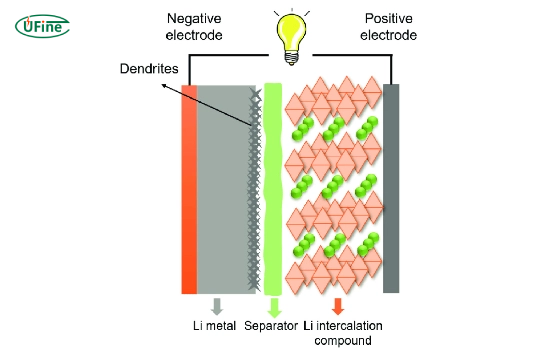Lithium metal batteries represent a significant advancement in energy storage technology, offering a range of advantages over conventional lithium-ion batteries. This comprehensive guide will explore everything you need about lithium metal batteries, from their fundamental principles to their applications, benefits, challenges, and prospects.
Part 1. What are lithium metal batteries?
Lithium metal batteries are a type of battery that primarily uses lithium metal as the anode material. Unlike lithium-ion batteries, which use a lithium compound for the anode, lithium-metal batteries typically provide higher energy density, allowing them to store more energy in a smaller volume. However, it is essential to note that most lithium metal batteries are non-rechargeable, which presents a significant challenge for their widespread use in applications requiring multiple charge cycles.
Components of Lithium Metal Batteries
- Anode: Made of lithium metal, which provides high energy density.
- Cathode: Typically composed of lithium compounds, such as lithium cobalt oxide or lithium iron phosphate.
- Electrolyte: A lithium salt dissolved in a solvent, facilitating the movement of lithium ions between the anode and cathode.
- Separator: A porous membrane that prevents direct contact between the anode and cathode while allowing ion flow.
Part 2. How do lithium metal batteries work?
Lithium metal batteries operate through electrochemical reactions. When you discharge the battery, lithium ions move from the anode to the cathode, generating electrical energy. This process is irreversible in non-rechargeable lithium metal batteries: once you consume the lithium, you can’t recharge the battery.
The Electrochemical Process
- Discharging: Lithium ions move from the anode to the cathode, releasing energy.
- Non-rechargeable Nature: Once you consume the lithium ions, you can’t recharge the battery, which limits its usability for long-term applications.
This mechanism allows lithium metal batteries to achieve higher energy densities than traditional lithium-ion batteries. Still, their non-rechargeable nature is a significant drawback.
Part 3. What are the advantages of lithium metal batteries?
Lithium metal batteries offer several advantages that make them an attractive option for various applications:
- Higher Energy Density: They can provide up to two times the energy density of conventional lithium-ion batteries, leading to more extended device usage.
- Lightweight: Lithium metal reduces the battery’s overall weight, which is crucial for applications in aerospace and electric vehicles.
- Faster Discharge Rates: Lithium metal batteries can discharge energy faster than traditional batteries, enhancing performance in high-demand applications.
- Improved Performance: They exhibit better performance in extreme temperatures, making them suitable for a broader range of environments.
Part 4. What are the challenges of lithium metal batteries?
Despite their advantages, lithium metal batteries also face several challenges that we need to address:
- Dendrite Formation: During discharge, lithium can form needle-like structures known as dendrites, which can penetrate the separator and cause short circuits.
- Safety Concerns: Lithium metal batteries are more prone to thermal runaway and fire due to their reactive nature.
- Non-rechargeable Design: Most manufacturers design lithium metal batteries for single-use, which limits their sustainability and increases waste.
- Cost: Lithium metal batteries can be more expensive to produce than traditional lithium-ion batteries, limiting their widespread adoption.
Part 5. How do lithium metal batteries compare to other battery technologies?
Several factors come into play when comparing lithium metal batteries to other battery technologies. Here’s a detailed overview of how they stack up against lithium-ion and nickel-metal hydride batteries:
Comparison Overview
- Energy Density: Lithium metal batteries have the highest energy density, making them ideal for applications where space and weight are critical. Lithium-ion batteries follow while nickel-metal hydride batteries have the lowest energy density.
- Weight: Lithium metal batteries are the lightest, a significant advantage in portable applications. Lithium-ion batteries are moderately lightweight, while nickel-metal hydride batteries tend to be heavier.
- Charge Time: Lithium metal batteries can discharge energy quickly, making them suitable for high-drain applications. However, they are not rechargeable. Lithium-ion batteries have a moderate charge time, while nickel-metal hydride batteries typically charge slowly.
- Cost: Lithium metal batteries are generally more expensive to produce than lithium-ion batteries, which are more cost-effective. Nickel-metal hydride batteries are usually the least costly option.
- Safety: Lithium-ion batteries have a better safety record than lithium-metal batteries, which are more prone to thermal runaway. Nickel-metal hydride batteries are considered safe but can still present risks.
| Feature | Lithium Metal Batteries | Lithium-Ion Batteries | Nickel-Metal Hydride Batteries |
|---|---|---|---|
| Energy Density | High | Moderate | Low |
| Weight | Light | Moderate | Heavy |
| Charge Time | Fast (Non-rechargeable) | Moderate | Slow |
| Cost | High | Moderate | Low |
| Safety | Moderate | High | Moderate |
Lithium metal batteries stand out primarily due to their high energy density and lightweight nature, making them ideal for applications where performance is critical.
Part 6. What are lithium metal batteries used for?
People are increasingly using lithium metal batteries in various applications, including:
- Consumer Electronics: Lithium metal batteries’ compact size and efficiency benefit devices such as cameras, drones, and portable medical devices.
- Aerospace: These batteries’ lightweight and high-performance characteristics are essential for aircraft and spacecraft applications.
- Military Applications: Their high energy density makes them suitable for military equipment, where weight and reliability are critical.
- Medical Devices: Due to their reliability and compact size, manufacturers use lithium metal batteries in various medical devices, including pacemakers and portable diagnostic equipment.
Part 7. What are the safety concerns with lithium metal batteries?
Safety is a critical aspect of battery technology. Lithium metal batteries have specific safety concerns:
- Thermal Runaway: If the battery overheats, it can cause a chain reaction that causes it to catch fire or explode.
- Dendrite Growth: As mentioned earlier, dendrites can form during discharge, potentially leading to short circuits.
- Chemical Reactivity: Lithium metal is highly reactive, especially in the presence of moisture, which can lead to hazardous situations.
Ongoing research focuses on improving battery design and materials to mitigate these risks.
Part 8. How to recycle lithium metal batteries?
Recycling lithium metal batteries is essential for sustainability and resource conservation. The recycling process typically involves:
- Collection: Collect used batteries from consumers and businesses.
- Sorting: Sort the batteries by chemistry to ensure proper processing.
- Processing: Dismantle the batteries and extract valuable materials such as lithium, cobalt, and nickel for reuse.
- Refinement: Extracted materials are refined and prepared for use in new batteries.
Consumers are encouraged to recycle their batteries at designated collection points to minimize environmental impact.
Part 9. FAQs
-
What are lithium metal batteries?
Lithium metal batteries are primarily non-rechargeable batteries that use lithium metal as the anode. They offer higher energy density than traditional lithium-ion batteries. -
What are the advantages of lithium metal batteries?
They provide higher energy density, are lightweight, discharge quickly, and perform well in extreme temperatures. -
What challenges do lithium metal batteries face?
Challenges include dendrite formation, safety concerns, non-rechargeable design, and higher production costs. -
What applications are lithium metal batteries used for?
People use them in consumer electronics, aerospace applications, military equipment, and medical devices. -
How can lithium metal batteries be recycled?
Recycling involves collection, sorting, processing, and refining to recover valuable materials for reuse.
Related Tags:
More Articles

LiPo Battery Discharge Rate Guide & Calculation Tips
Understand LiPo battery discharge rates, C-ratings, and how to calculate max current. Essential guide for RC, drones, and electronics users.
High‑Capacity 3S LiPo Batteries: 5000 mAh vs. 10000 mAh
Compare 3S LiPo 5000mAh vs 10000mAh batteries by weight, power, and use. Find the best fit for your drone, RC car, or boat setup.
Top 5 Applications for Small 3S LiPo Batteries
Small 3S LiPo batteries power drones, RC gear, wearables, and robotics with high energy and low weight. Making them ideal for compact electronics projects.
Building and Charging Your Own 3S LiPo Pack: A Step‑by‑Step Guide
Learn how to build, balance, and charge a 3S LiPo battery pack safely at home with this complete DIY guide for hobbyists and beginners.
How to Choose the Right LiPo Battery Plug Type?
Discover the best LiPo battery plug types, how to choose them, and expert tips for safe usage, soldering, and maintenance.




